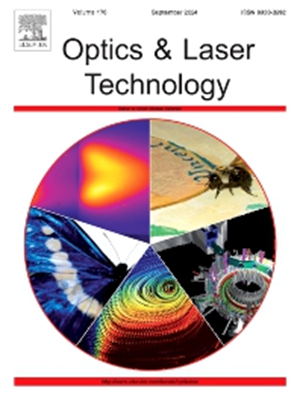A hybrid metallic waveguide with meta-holes for long-distance terahertz field enhancement
IF 4.6
2区 物理与天体物理
Q1 OPTICS
引用次数: 0
Abstract
High-intensity terahertz (THz) field is crucial for various practical applications. Several structures have been used to achieve THz field enhancement, but the propagation distances of the high-intensity field can only be maintained at the wavelength or sub-wavelength scale. Here, a hybrid metallic waveguide with meta-holes (HMWMH) based on the combination of waveguide technologies and wavefront control methods is proposed to achieve THz field enhancement over a much longer propagation distance. By the phase modulation of meta-holes, THz waves incident on the waveguide can be converted into a guided mode and further focused at the center. To achieve the second field enhancement, the enhanced THz field at the focus is coupled into a triangular single ridge waveguide, which supports surface plasmon polaritons (SPPs) with deep-subwavelength mode widths and ultra-low loss. When the radius of the ridge tip and the gap between the tip and metallic plate are 15 and 100 μm, respectively, a hot spot area of 19.2 × 3.3 μm2 (1.38 × 10-5 λ2) and a field enhancement of 689 times are achieved simultaneously in the simulation. Theoretically the high-intensity THz field can propagate over a distance of 1.8 m due to the ultra-low loss of the SPPs, which is several orders of magnitude larger than the wavelength. According to the design, an HMWMH prototype is fabricated, and the simulated and measured results are consistent with each other. By realizing long-distance THz field enhancement, the HMWMH can greatly enhance light-matter interactions, which can promote the development of integrated THz photonic devices, THz biophotonics, and THz nonlinear photonics.
求助全文
约1分钟内获得全文
求助全文
来源期刊
CiteScore
8.50
自引率
10.00%
发文量
1060
审稿时长
3.4 months
期刊介绍:
Optics & Laser Technology aims to provide a vehicle for the publication of a broad range of high quality research and review papers in those fields of scientific and engineering research appertaining to the development and application of the technology of optics and lasers. Papers describing original work in these areas are submitted to rigorous refereeing prior to acceptance for publication.
The scope of Optics & Laser Technology encompasses, but is not restricted to, the following areas:
•development in all types of lasers
•developments in optoelectronic devices and photonics
•developments in new photonics and optical concepts
•developments in conventional optics, optical instruments and components
•techniques of optical metrology, including interferometry and optical fibre sensors
•LIDAR and other non-contact optical measurement techniques, including optical methods in heat and fluid flow
•applications of lasers to materials processing, optical NDT display (including holography) and optical communication
•research and development in the field of laser safety including studies of hazards resulting from the applications of lasers (laser safety, hazards of laser fume)
•developments in optical computing and optical information processing
•developments in new optical materials
•developments in new optical characterization methods and techniques
•developments in quantum optics
•developments in light assisted micro and nanofabrication methods and techniques
•developments in nanophotonics and biophotonics
•developments in imaging processing and systems

 求助内容:
求助内容: 应助结果提醒方式:
应助结果提醒方式:


